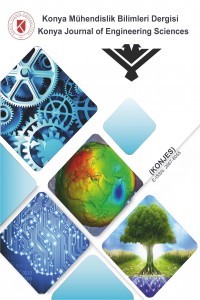NUMERICAL ANALYSES OF THERMAL PERFORMANCES OF THE CONVENTIONAL AND THE IMMERSION COOLING METHODS FOR LITHIUM-ION BATTERY PACKS
NUMERICAL ANALYSES OF THERMAL PERFORMANCES OF THE CONVENTIONAL AND THE IMMERSION COOLING METHODS FOR LITHIUM-ION BATTERY PACKS
Battery Pack Thermal Management, Dielectric Coolant, Efficiency and Performance, Electrical Vehicles Energy, Finite Volumes Analysis,
___
- Amalesh, T., Narasimhan, L. N., ‘‘Cooling of a lithium-ion battery using phase change material with air/dielectric fluid media: A numerical study’’, Journal of Power and Energy, vol. 234(5), pp. 722-738, 2020.
- E. Langer, “Liquid cooling for EV charging – what we know to keep electric vehicles on the go,” 2019. [Online]. Available: https://www.cpcworldwide.com/Portals/0/Library/Resources/Literature/WhitePapers/Documents/CPC-Liquid%20Cooling%20in%20Electric%20Vehicles.pdf [Accessed Feb. 2023].
- EPA, “US Environmental Protection Agency,” 2022. [Online]. Available: https://www.epa.gov/ [Accessed Jan. 2023].
- Castrol, “Castrol Coolant Fluent,” 2022. [Online]. Available: https://www.castrol.com/tr_tr/turkey/home/technology-and-innovation/castrol-e-sivilari/sogutucu-e-sivilari.html [Accessed Feb. 2023].
- Mivolt, “Liquid Immersion Cooling,” 2022. [Online]. Available: https://mivoltcooling.com/ [Accessed Feb. 2023].
- Zhao, G., Wang, X., Negnevitsky, M., Li, C., ‘‘An up-to-date review on the design improvement and optimization of the liquid-cooling battery thermal management system for electric vehicles’’, Applied Thermal Energy, vol 219, part B, 25 Jan 2023, 119626, Nov. 2022.
- Xing, “Xing Mobility Technology,” 2022. [Online]. Available: https://www.xingmobility.com/ [Accessed Feb. 2023].
- Z. Rao, S. Wang, ‘‘A review of power battery thermal energy management’’, Renewable and Sustainable Energy Reviews, vol 15, issue 9, pp 4551-4571, Dec 2011.
- J. Han, S. K. Garud, S. Hwang, Y. Lee, ‘‘Experimental Study on Dielectric Fluid Immersion Cooling for Thermal Management of Lithium-Ion Battery’’, Symmetry/Asymmetry in Advanced Research for Efficient Electric Vehicles, vol 14(10), 2126, 2022.
- C. Roe, X. Feng, G. White, R. Li, H. Wang, R. Xinyu, X. Li, F. Zhang, V. Null, M. Perkes, Y. Patel, Y. Wang, H. Wang, M. Ouyang, G. Offer, B. Wu, ‘‘Immersion cooling for lithium-ion batteries – A review’’, Journal of Power Sources, vol 525, 231094, March 2022.
- X. Zhang, L. Zhao, L. Luo, Y. Fan, Z. Du, ‘’A review on thermal management of lithium-ion batteries for electric vehicles’’, Energy, Volume 238, Part A, 121652, January 2022.
- D. Chen, J. Jiang, G. Kim, C. Yang, ‘’Comparison of different cooling methods for lithium-ion battery cells’’, Applied Thermal Engineering, 94(2), September 2015.
- M. Liu, Y. Ouyang, Y. Cheng L. Lu, "A comparative study of air cooling, liquid cooling and phase change cooling in lithium-ion batteries thermal management for electric vehicles," Applied Energy, vol. 211, pp. 51-60, Feb. 2018.
- M. Zhao, Z. Lu, W. Wang, J. Liu, K. Cheng, "Experimental Study on Thermal Performance of Three Kinds of Cooling Methods for Lithium-Ion Power Battery," Applied Thermal Engineering, vol. 145, pp. 87-94, Oct. 2018.
- A. Herman, ‘‘Liquid cooling manifold with multi-function thermal interface,’’ U.S. Patent US8263250B2, 2010.
- M. S. Çetin, B. Karakaya, T. M. Gençoğlu, ‘‘Modelling of Lithium-Ion Batteries for Electric Vehicles’’, Fırat University Journal of Engineering Sciences, vol. 33(2), 755-763, 2021.
- P. Ramadass, B. Haran, R. White, N. B. Popov, ‘‘Capacity fade of Sony 18650 cells cycled at elevated temperatures: Part I. Cycling performance’’, Journal of Power Sources, vol. 112, issue 2, pp. 606-613, Nov. 2002.
- E. Çetkin, ‘‘The rise of electric vehicles and battery thermal management system’’, Engineer and Machine, pp. 29-33, Nov. 2020.
- Alldatasheet, Cell Properties, 2022. [Online]. Available: https://www.alldatasheet.com/ [Accessed Jan. 2023].
- ANSYS, Fluent. ANSYS, Inc. [Online]. Available: https://www.ansys.com/products/fluids/ansys-fluent [Accessed Jan. 2023].
- C. Bayındırlı, M. Çelik, M. Demiraylı, ‘‘The Investigation of Flow Characteristic Around a Bus Model by CFD Method and Improvement of Drag Force by Passive Flow Control Method’’, Journal of Polytechnic, vol. 21(4), pp. 785-795, 2018.
- G. A. Stefanopoulou, Y. Kim, ‘‘System-level management of rechargeable lithium-ion batteries’’, Rechargeable Lithium Batteries from Fundamentals to Applications, Woodhead Publishing Series in Energy, pp. 281-302, 2015.
- P. Kosky, G. Wise, ‘‘Convection Heat Transfer Coefficient – An overview’’, Exploding Engineering, 2013.
- Y. M. Kaba, O. Kalkan, A. Celen, ‘‘The Investigation of Batteries and Thermal Management Systems Used in Electric Vehicles’’, Konya Journal of Engineering Sciences, vol.9, no. 4, 1119-1136, 2021.
- V. Mali, R. Saxena, K. Kumar, A. Kalam, B. Tripathi, ‘‘Review on battery thermal management systems for energy-efficient electric vehicles’’, Renewable and Sustainable Energy Reviews, vol 151, 111611, Nov. 2021.
- P. Dubey, G. Pulugundla, K. A. Srouji, Direct Comparison of Immersion and Cold-Plate Based Cooling for Automotive Li-Ion Battery Modules, Energies, vol. 14(5), 1259, 2021.
- K. V. Jithin, P. K. Rajesh, "Numerical analysis of single-phase liquid immersion cooling for lithium-ion battery thermal management using different dielectric fluids’’, International Journal of Heat and Mass Transfer, vol. pp. 188, 2022.
- S. M. Patil, J. Seo, M. Lee, ‘‘A novel dielectric fluid immersion cooling technology for Li-ion battery thermal management’’, Energy Conversion and Management, vol. 229, 113715, Feb. 2021.
- Yayın Aralığı: Yılda 4 Sayı
- Başlangıç: 2004
- Yayıncı: Konya Teknik Üniversitesi
KİL MİNERALLERİNİN KÖMÜRÜN FLOTASYON PERFORMANSINA VE ORTALAMA KABARCIK BOYUTUNA ETKİSİ
Vildan ÖNEN, Ayşe Zeynep ÇAĞLAR, Hasan Ali TANER
Akif YAVUZSOY, Hüseyin SARGIN, Tuğçe YAREN, Selçuk KİZİR
Fatma DEMİR, Gülden GÖKŞEN, Didem DEMİR KARAKUŞ
AYRI OPTİMİZASYON PROBLEMLERİ İÇİN SİMETRİ YÖNTEMLİ AYRIK BİR PARÇACIK SÜRÜSÜ ALGORİTMASI
DATA INTEGRITY AND QUALITY ANALYSIS OF LOW COST ZED-F9P U-BLOX GNSS RECEIVER
Sermet ÖĞÜTCÜ, Salih ALÇAY, Hüseyin DUMAN, Behlül Numan ÖZDEMİR, Ülkünur KORAY
FEATURES OF THE HAJAR AL‐ASWAD, BLACK STONE OF MAKKAH, SAUDI ARABIA
